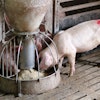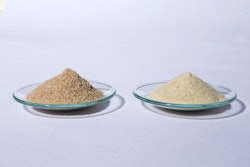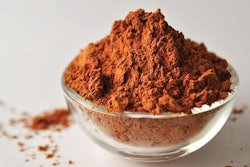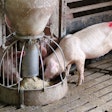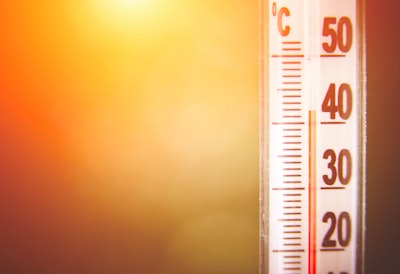
Sustainable food systems require feed ingredients that mitigate heat stress, researchers say
In the scorching Sonoran Desert, agricultural production is on the rise — and the temperatures are, too.
Ambient summertime temperatures already reach 50 degrees Celsius (122 degrees Fahrenheit) in agricultural centers in the Mexicali Valley, where Miguel Cervantes Ramirez researches animal feed and husbandry at the Autonomous University of Baja California. “In addition, with climate change, we have seen a general increase in ambient temperatures overall in Mexico,” Cervantes said. “Temperature increments are not as high as those we experience every summer in Mexicali, but those are significant.”
Moreover, temperatures are rising all around the world, Cervantes adds, yet the world’s population continues to grow, increasing demand for meat, eggs and milk. By the year 2050, Sami Dridi, a professor of poultry science at the University of Arkansas, estimates that worldwide demand for protein production will increase by 73%.
Much of the increase is needed regions with warmer climates — and these climates aren’t getting any cooler — leaving livestock producers with no choice but to address heat stress directly.
Heat stress, according to Dridi, was responsible for $165 million in losses in the U.S. poultry industry — 17 years ago. In addition to potential fatalities, conditions brought on by stress decrease animal growth and productivity, adding even more difficulty to the challenge of feeding a growing population on a warming planet.
Researchers like Cervantes and Dridi have spent the better part of two decades trying to understand why modern livestock is more susceptible to heat stress than in the past, and what can be done to mitigate it. The good news, they say, is that a variety of feed ingredients, nutritional strategies and environmental controls seem to help. But a missing scientific link — the biological roots of heat stress are not entirely understood — there’s no single solution, they say.
The thermal effect of feeding
Although scientists don’t currently understand the exact biological mechanisms responsible for the symptoms associated with heat stress, high temperatures appear to trigger a sort of metabolic chain-reaction in multiple livestock species that can result in reduced feed intake, slow growth, organ damage and even death.
“They eat less, and if they eat less, they grow less,” Dridi said. “Even if you save the chickens, at the end of the day, you have less meat.”
Depending on the species and how high the ambient temperature gets, heat stress can reduce feed intake by 20-50%, according to Cervantes. This symptom, he said, is caused primarily by a phenomenon called the thermal effect of feeding. Essentially, digestion generates heat, but on hot days, an animal’s body temperature also begins to rise. In an effort to maintain their ideal body temperatures, animals will voluntarily restrict their feed intake “as an attempt to reduce further increase in body temperature,” Cervantes said.
Today’s livestock may be even more susceptible to this thermal effect of feeding than in the past, according to Dridi. Faster growing animals have high metabolic rates, but this rapid metabolism also produces more internal heat and puts animals less resilient in hot climates.
Some feed components such as fiber and protein generate more heat during digestion than other ingredients, according to Marcos Rostagno, a veterinarian and technical and regulatory director at Phytobiotics North America. To combat this, he said, most nutritionists will put livestock on “summer diets” that contain less protein and more fat to improve digestion without reducing energy intake. These summer diets are also often more concentrated to combat the effects of reduced feed intake.
But recent research, including work by Cervantes’s team in Mexico, suggests another possibility: adding essential amino acids in free form in the place of protein-bound amino acids. This allows the animal to digest protein more easily, reducing body temperature, and also increases the overall amount of amino acids in the diet to compensate for reduced feeding.
 Driven by climate change, researchers seek feed ingredients to mitigate heat stress. (danchooalex | iStockPhoto.com)
Driven by climate change, researchers seek feed ingredients to mitigate heat stress. (danchooalex | iStockPhoto.com)Beyond protein solutions
While most producers focus on the impact of heat stress on feed intake, this isn’t the only way high temperatures affect animal health and welfare.
Heat-stressed livestock not only exhibits reduced feed intake due to changes in behavior but also become less able to absorb nutrients due to decreased function in the intestines and other organs.
Overheated animals will redirect the flow of blood, increasing flow in the skin and extremities, at the expense of internal organs. This enables the animal to cool itself, but also results in decreased organ function, according to Rostagno.
Initially, this reduces the ability of the gut to digest and absorb nutrients, but long-term it can result in inflammation and organ damage.
Ingredients with anti-inflammatory or antioxidant properties, such as some vitamins, some plant extracts and even minerals like zinc, have the potential to counter these negative results of heat stress.
The loss of organ function may also result in “leaky gut,” which allows bacteria to infect the animal more easily, Dridi said. This could explain why probiotics, in some cases, appear to help mitigate heat stress.
All of these ingredients hold promise, Dridi said, but he doesn’t believe one single additive can address all the compounding effects of heat stress.
“At the end of the day, I think you need a combination of all those components,” he said. “I don’t think one strategy is enough.”
A holistic approach to heat stress
As a veterinarian, Rostagno said, producers used to ask him all the time whether it was possible to raise chickens without antibiotics. “That’s not the question,” he said. “The question is: Are you ready to raise chickens without antibiotics?”
The same question applies to heat stress, Rostagno said, “because, if you don’t do the basics, it’s not going to work.”
Ingredients that show promise in university laboratories don’t always pan out when used in the field, Rostagno continued. There are some reasons for this — not the least of which is the fact that it’s easier to measure small improvements in a precisely controlled laboratory setting. There’s also the reality that the variability of local climates may influence how feed and dietary changes impact an animal. Europe just doesn’t have the same weather conditions as Mexico, and animals in each of those settings may require different solutions.
But often, Rostagno said, the failure is related to other environmental conditions, like the accessibility or temperature of the water.
“I’ve known producers who say the water temperature is fine,” he said, “but you put your finger in it and it’s warm.”
If a barn is too crowded, lacks ventilation or if the animals lack access to cool water on hot days, Rostagno said, adding heat-mitigating ingredients to the feed isn’t likely to bring about the desired results.
But once basic environmental factors are controlled, feed additives do potentially have a role to play in modern production systems — particularly as more producers move to free-range and organic methods, Rostagno said.
Many dietary controls, Cervantes said, are also more cost-effective and better for the environment than energy-intensive mechanical solutions like fans or sprinklers.
“The idea,” Dridi concurred, “is to improve the chicken’s wellbeing, maintain growth and improve the sustainability of poultry production because we need sustainable poultry production to feed the future.”

